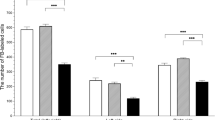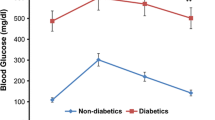Summary
The guinea pig uterus is supplied by different populations of nerves which can be demonstrated by specific immunocytochemical and histochemical techniques. So far, there has been no single marker displaying entire peripheral innervation patterns. Recently, protein gene product (PGP) 9.5, a cytoplasmic protein in neurons and neuroendocrine cells, was found to visualize both different populations and subtypes of nerves. This prompted the present study of using PGP 9.5 for visualization of the whole uterine innervation. This was performed by the indirect immunofluorescence method using antiserum to PGP 9.5 raised in rabbits.
PGP-immunoreactivity was present in all neuronal parts of the extrinsic and intrinsic uterine innervation, including different subpopulations of nerves. This was verified by chemical sympathectomy and sensory denervation with 6-hydroxydopamine and capsaicin-treatment respectively, and double immunostaining.
By term a disappearance of uterine PGP-nerve-immunoreactivity was observed which was almost complete in fetus-bearing uterine tissue and further strengthens previous assumptions of a general, pregnancy-induced uterine neuronal degeneration.
The developmental time-course and morphology of PGP-immunoreactive nerve structures was similar to that for other neuronal markers and support the suggestion of PGP-immunoreactivity as a general marker for the entire uterine innervation, and suggests that the presence of PGP 9.5-immunoreactivity may coincide with functional maturation of uterine innervation.
Similar content being viewed by others
References
Alm P, Lundberg L-M (1988) Co-existence and origin of peptidergic and adrenergic nerves in the guinea-pig uterus: Retrograde tracing and immunocytochemistry. Effect of chemical sympathectomy, capsaicin treatment and pregnancy. Cell Tissue Res 254 (in press)
Alm P, Lundberg L-M, Wharton J, Polak JM (1988a) Organization of the guinea pig uterine innervation. Distribution of immunoreactivities for different neuronal markers. Effects of chemical and pregnancy-induced sympathectomy. Histochem J (in press)
Alm P, Lundberg L-M, Wharton J, Polak JM (1988b) Effects of pregnancy on the extrinsic innervation of the guinea-pig uterus. A histochemical, immunohistochemical and ultrastructural study. Histochem J (in press)
Alm P, Lundberg L-M, Wharton J, Polak JM (1988c) Ontogenetic development of the guinea pig uterine innervation. An immunohistochemical study of different neuronal markers, neuropeptides and S-100 protein. Histochemistry 90:19–24
Bignami A, Chi NH, Dahl D (1986) Neurofilament phosphorylation in peripheral nerve regeneration. Brain Res 375:73–82
Bishop AE, Carlei F, Lee V, Trojanowski J, Marangos PJ, Dahl D, Polak JM (1985) Combined immunostaining of neurofilaments, neuron specific enolase, GFAP and S-100. A possible means for assessing the morphological and functional status of the enteric nervous system. Histochemistry 82:93–97
Burks TF, Buck S, Miller MS (1985) Mechanisms of depletion of substance P by capsaicin. Fed Proc 44:2531–2534
Coons AH, Leduc EH, Conolly JM (1955) Studies on antibody production. I. A method for histochemical demonstration of specific antibody and its application to a study of the hyperimmune rabbit. J Exp Med 102:49–60
Cowen T, haven AJ, Burnstock G (1985) Pontamine sky blue: a counterstain for background autofluorescence in fluorescence and immunofluorescence histochemistry. Histochemistry 82:205–308
Dahl D, Grossi M, Bignami A (1984) Masking of epitopes in tissue section. A study of glial fibrillary acidic (GFA) protein with antisera and monoclonal antibodies. Histochemistry 81:525–531
Doran JF, Jackson PJ, Kynoch PAM, Thompson RJ (1983) Isolation of PGP 9.5, a new human neurone-specific protein detected by high resolution two dimensional electrophoresis. J Neurochem 40:1542–1547
Draper RL (1920) The prenatal growth of the guinea-pig. Anat Rec 18:369–392
Fried G, Hökfelt T, Terenius L, Goldstein M (1985) Neuropeptide Y (NPY)-like immunoreactivity in guinea-pig uterus is reduced during pregnancy in parallel with noradrenergic nerves. Histochemistry 83:437–442
Friede RL, Samorajski T (1970) Axon calibre related to neurofilaments and microtubules in sciatic nerve fibres of rats and mice. Anat Rec 167:379–388
Gamse R, Molnar A, Lembeck F (1979) Substance P release from spinal cord slices by capsaicin. Life Sci 25:629–636
Gulbenkian S, Wharton J, Polak JM (1987) The visualisation of cardiovascular innervation in the guinea-pig using an antiserum to protein gene product 9.5 (PGP 9.5). J Auton Nerv Syst 19:235–247
Hacker GW, Polak JM, Springall DR, Ballesta J, Cadieux A, Gu J, Trojanowski JQ, Dahl D, Marangos PJ (1985) Antibodies to neurofilament protein and other brain proteins reveal the innervation of peripheral organs. Histochemistry 82:581–593
Hammarström M, Sjöstrand NO (1979) Evidence for a cholinergic secretory innervation of the guinea-pig endometrium. Acta Physiol Scand 106:11–15
Hoffman PN, Griffin JW, Price DL (1984) Neurofilament transport in axonal regeneration. Implications for the control of axonal caliber. In: Elam JS, Cancalon P (eds) Axonal transport in neuronal growth and regeneration. Plenum Press, New York, pp 243–260
Jackson GD, Thompson RJ (1981) The demonstration of new human brain-specific proteins by high-resolution two-dimensional polyacrylamide gel electrophoresis. J Neurol Sci 49:429–438
Jackson P, Thompson VM, Thompson RJ (1985) A comparison of the evolutionary distribution of the two neuroendocrine markers, neurone-specific enolase and protein gene product 9.5. J Neurochem 45:185–190
Johnson GD, Nogueira Araujo GM (1981) A simple method of reducing the fading of immunofluorescence during microscopy. J Immunol Methods 43:349–450
Kaufmann P (1969) Die Meerschweinchen-placenta und ihre Entwicklung. Z Anat Entwicklungsgesch 129:83–101
Lawson SN, Harper AA, Harper EI, Garson JA, Anderton BH (1984) A monoclonal antibody against neurofilament protein specifically labels a subpopulation of rat sensory neurones. J Comp Neurol 228:263–272
Lundberg JM, Franco-Cereceda A, Hua X, Hökfelt T, Fischer JA (1985a) Co-existence of substance P and calcitonin gene-related peptide-like immunoreactivities in sensory nerves in relation to cardiovascular and bronchoconstrictor effects of capsaicin. Eur J Pharmacol 108:315–319
Lundberg JM, Saria A, Theodorsson-Norheim E, Brodin E, Hua X, Martling C-R, Gamse R, Hökfelt T (1985b) Multiple tachykinins in capsaicin-sensitive afferents: occurrence, release and biological effects with special reference to irritation of the airways. In: Håkanson R, Sundler F (eds) Tachykinin antagonists. Elsevier, Amsterdam, pp 159–169
Lundberg L-M, Alm P, Carlén B (1987) S-100 immunoreactive nerves in the guinea-pig uterus. Effects of chemical sympathectomy and pregnancy. Cell Tissue Res 250:241–249
Papka RE, Furness JB, Della NG, Murphy R, Costa M (1984) Time course of effect of capsaicin on ultrastructure and histochemistry of substance P-IR nerves associated with the cardiovascular system of the guinea-pig. Neuroscience 12:1277–1292
Peters A, Vaughn JE (1967) Microtubules and filaments in the axons and astrocytes of early postnatal rat optic nerves. J Cell Biol 32:113–119
Rode J, Dhillon AP, Doran JF, Jackson P, Thompson RJ (1985) PGP 9.5, a new marker for human neuroendocrine tumours. Histopathology 9:147–158
Schmechel D, Marangos PJ, Athanasios PZ, Brightman M, Goodwin F (1978) Brain enolases as specific markers of neuronal and glial cells. Science 199:313–315
Theodorsson-Norheim E, Hua X, Brodin E, Lundberg JM (1985) Capsaicin treatment decreases tissue levels of neurokinin A-like immunoreactivity in the guinea-pig. Acta Physiol Scand 145:129–131
Thompson RJ, Doran JF, Jackson P, Shillon AP, Rode J (1983) PGP 9.5 — a new marker for vertebrate neurons and neuroendocrine cells. Brain Res 278:224–228
Thorbert G (1979) Regional changes in structure and function of adrenergic nerves in guinea-pig uterus during pregnancy. Acta Obstet Gynecol Scand (Suppl) 79:1–32
Thorbert G, Alm P, Owman Ch, Sjöberg N-O (1977) Regional distribution of autonomic nerves in guinea pig uterus. Am J Physiol 233:C25–C34
Thorbert G, Alm P, Owman Ch, Sjöberg N-O, Sporrong B (1978) Regional changes in structural and functional integrity of myometrial adrenergic nerves in pregnant guinea-pig, and their structural relationship to the localization of the conceptus. Acta Physiol Scand 103:120–131
Trojanowski JW, Obrocka MA, Lee VMY (1985) Distribution of neurofilament subunits in neurons and neuronal processes: immunohistochemical studies of bovine cerebellum with subunit-specific monoclonal antibodies. J Histochem Cytochem 33:557–563
Wessendorf MW, Elde RP (1985) Characterization of an immunofluorescence technique for the demonstration of coexisting neurotransmitters within nerve fibres and terminals. J Histochem Cytochem 33:984–994
Author information
Authors and Affiliations
Rights and permissions
About this article
Cite this article
Lundberg, L.M., Alm, P., Wharton, J. et al. Protein gene product 9.5 (PGP 9.5). Histochemistry 90, 9–17 (1988). https://doi.org/10.1007/BF00495700
Received:
Accepted:
Issue Date:
DOI: https://doi.org/10.1007/BF00495700




